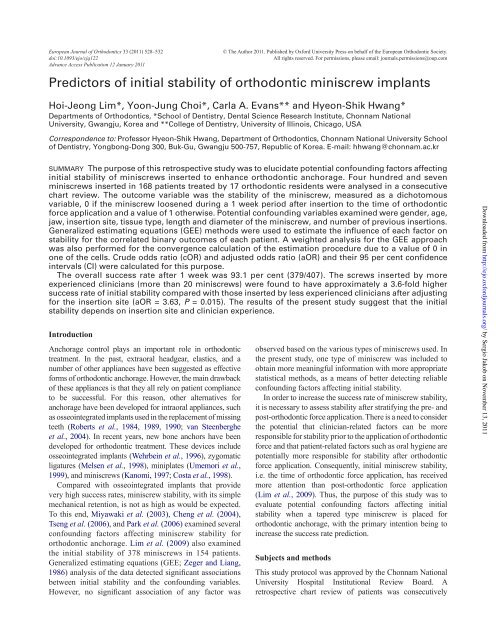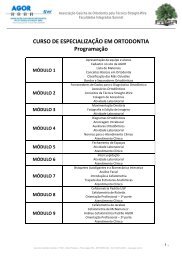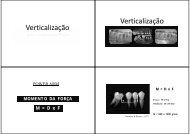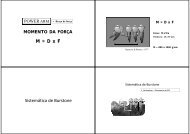Predictors of initial stability of orthodontic miniscrew implants
Predictors of initial stability of orthodontic miniscrew implants
Predictors of initial stability of orthodontic miniscrew implants
Create successful ePaper yourself
Turn your PDF publications into a flip-book with our unique Google optimized e-Paper software.
European Journal <strong>of</strong> Orthodontics 33 (2011) 528–532 © The Author 2011. Published by Oxford University Press on behalf <strong>of</strong> the European Orthodontic Society.<br />
doi:10.1093/ejo/cjq122 All rights reserved. For permissions, please email: journals.permissions@oup.com<br />
Advance Access Publication 12 January 2011<br />
<strong>Predictors</strong> <strong>of</strong> <strong>initial</strong> <strong>stability</strong> <strong>of</strong> <strong>orthodontic</strong> <strong>miniscrew</strong> <strong>implants</strong><br />
Hoi-Jeong Lim*, Yoon-Jung Choi*, Carla A. Evans** and Hyeon-Shik Hwang*<br />
Departments <strong>of</strong> Orthodontics, *School <strong>of</strong> Dentistry, Dental Science Research Institute, Chonnam National<br />
University, Gwangju, Korea and **College <strong>of</strong> Dentistry, University <strong>of</strong> Illinois, Chicago, USA<br />
Correspondence to: Pr<strong>of</strong>essor Hyeon-Shik Hwang, Department <strong>of</strong> Orthodontics, Chonnam National University School<br />
<strong>of</strong> Dentistry, Yongbong-Dong 300, Buk-Gu, Gwangju 500-757, Republic <strong>of</strong> Korea. E-mail: hhwang@chonnam.ac.kr<br />
SUMMARY The purpose <strong>of</strong> this retrospective study was to elucidate potential confounding factors affecting<br />
<strong>initial</strong> <strong>stability</strong> <strong>of</strong> <strong>miniscrew</strong>s inserted to enhance <strong>orthodontic</strong> anchorage. Four hundred and seven<br />
<strong>miniscrew</strong>s inserted in 168 patients treated by 17 <strong>orthodontic</strong> residents were analysed in a consecutive<br />
chart review. The outcome variable was the <strong>stability</strong> <strong>of</strong> the <strong>miniscrew</strong>, measured as a dichotomous<br />
variable, 0 if the <strong>miniscrew</strong> loosened during a 1 week period after insertion to the time <strong>of</strong> <strong>orthodontic</strong><br />
force application and a value <strong>of</strong> 1 otherwise. Potential confounding variables examined were gender, age,<br />
jaw, insertion site, tissue type, length and diameter <strong>of</strong> the <strong>miniscrew</strong>, and number <strong>of</strong> previous insertions.<br />
Generalized estimating equations (GEE) methods were used to estimate the influence <strong>of</strong> each factor on<br />
<strong>stability</strong> for the correlated binary outcomes <strong>of</strong> each patient. A weighted analysis for the GEE approach<br />
was also performed for the convergence calculation <strong>of</strong> the estimation procedure due to a value <strong>of</strong> 0 in<br />
one <strong>of</strong> the cells. Crude odds ratio (cOR) and adjusted odds ratio (aOR) and their 95 per cent confidence<br />
intervals (CI) were calculated for this purpose.<br />
The overall success rate after 1 week was 93.1 per cent (379/407). The screws inserted by more<br />
experienced clinicians (more than 20 <strong>miniscrew</strong>s) were found to have approximately a 3.6-fold higher<br />
success rate <strong>of</strong> <strong>initial</strong> <strong>stability</strong> compared with those inserted by less experienced clinicians after adjusting<br />
for the insertion site (aOR = 3.63, P = 0.015). The results <strong>of</strong> the present study suggest that the <strong>initial</strong><br />
<strong>stability</strong> depends on insertion site and clinician experience.<br />
Introduction<br />
Anchorage control plays an important role in <strong>orthodontic</strong><br />
treatment. In the past, extraoral headgear, elastics, and a<br />
number <strong>of</strong> other appliances have been suggested as effective<br />
forms <strong>of</strong> <strong>orthodontic</strong> anchorage. However, the main drawback<br />
<strong>of</strong> these appliances is that they all rely on patient compliance<br />
to be successful. For this reason, other alternatives for<br />
anchorage have been developed for intraoral appliances, such<br />
as osseointegrated <strong>implants</strong> used in the replacement <strong>of</strong> missing<br />
teeth (Roberts et al., 1984, 1989, 1990; van Steenberghe<br />
et al., 2004). In recent years, new bone anchors have been<br />
developed for <strong>orthodontic</strong> treatment. These devices include<br />
osseointegrated <strong>implants</strong> (Wehrbein et al., 1996), zygomatic<br />
ligatures (Melsen et al., 1998), miniplates (Umemori et al.,<br />
1999), and <strong>miniscrew</strong>s (Kanomi, 1997; Costa et al., 1998).<br />
Compared with osseointegrated <strong>implants</strong> that provide<br />
very high success rates, <strong>miniscrew</strong> <strong>stability</strong>, with its simple<br />
mechanical retention, is not as high as would be expected.<br />
To this end, Miyawaki et al. (2003), Cheng et al. (2004),<br />
Tseng et al. (2006), and Park et al. (2006) examined several<br />
confounding factors affecting <strong>miniscrew</strong> <strong>stability</strong> for<br />
<strong>orthodontic</strong> anchorage. Lim et al. (2009) also examined<br />
the <strong>initial</strong> <strong>stability</strong> <strong>of</strong> 378 <strong>miniscrew</strong>s in 154 patients.<br />
Generalized estimating equations (GEE; Zeger and Liang,<br />
1986<br />
between <strong>initial</strong> <strong>stability</strong> and the confounding variables.<br />
<br />
observed based on the various types <strong>of</strong> <strong>miniscrew</strong>s used. In<br />
the present study, one type <strong>of</strong> <strong>miniscrew</strong> was included to<br />
obtain more meaningful information with more appropriate<br />
statistical methods, as a means <strong>of</strong> better detecting reliable<br />
confounding factors affecting <strong>initial</strong> <strong>stability</strong>.<br />
In order to increase the success rate <strong>of</strong> <strong>miniscrew</strong> <strong>stability</strong>,<br />
it is necessary to assess <strong>stability</strong> after stratifying the pre- and<br />
post-<strong>orthodontic</strong> force application. There is a need to consider<br />
the potential that clinician-related factors can be more<br />
responsible for <strong>stability</strong> prior to the application <strong>of</strong> <strong>orthodontic</strong><br />
force and that patient-related factors such as oral hygiene are<br />
potentially more responsible for <strong>stability</strong> after <strong>orthodontic</strong><br />
force application. Consequently, <strong>initial</strong> <strong>miniscrew</strong> <strong>stability</strong>,<br />
i.e. the time <strong>of</strong> <strong>orthodontic</strong> force application, has received<br />
more attention than post-<strong>orthodontic</strong> force application<br />
(Lim et al., 2009). Thus, the purpose <strong>of</strong> this study was to<br />
evaluate potential confounding factors affecting <strong>initial</strong><br />
<strong>stability</strong> when a tapered type <strong>miniscrew</strong> is placed for<br />
<strong>orthodontic</strong> anchorage, with the primary intention being to<br />
increase the success rate prediction.<br />
Subjects and methods<br />
This study protocol was approved by the Chonnam National<br />
University Hospital Institutional Review Board. A<br />
retrospective chart review <strong>of</strong> patients was consecutively<br />
Downloaded from<br />
http://ejo.oxfordjournals.org/<br />
by Sergio Jakob on November 13, 2011
INITIAL STABILITY OF MINISCREWS<br />
conducted at the Graduate Orthodontic Clinic <strong>of</strong> Chonnam<br />
National University Hospital from 2003 to 2005. A total <strong>of</strong><br />
407 tapered <strong>miniscrew</strong>s <strong>of</strong> various sizes (Orlus; Ortholution<br />
Inc., Seoul, Korea) in 168 patients (51 males and 117 females;<br />
mean age ± SD = 23.0 ± 8.7 years) were included in this<br />
study. This type <strong>of</strong> <strong>miniscrew</strong> tapers from a larger head<br />
diameter to a smaller diameter at its tip; the screw diameter is<br />
measured at the midpoint from the neck to the tip <strong>of</strong> the screw.<br />
The <strong>miniscrew</strong>s were placed directly with a hand-driven<br />
screwdriver without pre-drilling. For this study, detailed<br />
patient information was obtained from lateral cephalometric<br />
<br />
The potential confounding variables examined were divided<br />
into three categories: patient, <strong>miniscrew</strong>, and operator-related.<br />
Patient factors were related to gender, age (less than 15, more<br />
than 15 and less than 20, more than 20 and less than 25, and<br />
more than 25 years), jaw (maxilla or mandible), insertion sites,<br />
and tissue type (keratinized or non-keratinized). The<br />
<strong>miniscrew</strong>s were inserted into the following areas: maxillary<br />
<br />
palatal slope (between the maxillary second premolar and<br />
<br />
(the midline <strong>of</strong> the palate corresponding to the area between<br />
<br />
<br />
<br />
canine (distal to canine), or other (between the mandibular<br />
incisors or mandibular retromolar area). The palatal mucosa<br />
<br />
<br />
tissue. Miniscrew factors included diameter and length<br />
<strong>of</strong> the <strong>miniscrew</strong>: diameters 1.6 and 1.8 mm and lengths<br />
6, 7, 8, and 10 mm. Operator factor referred to the number<br />
<strong>of</strong> previous insertions conducted by the 17 <strong>orthodontic</strong><br />
residents.<br />
Stability <strong>of</strong> the <strong>miniscrew</strong>s was assessed 1 week after<br />
<br />
immediately after insertion compared with pre-drill type<br />
screws. No load was applied to the screws after placement,<br />
before assessment <strong>of</strong> <strong>stability</strong>. While the <strong>initial</strong> <strong>stability</strong> was<br />
the outcome variable <strong>of</strong> this study, each response variable<br />
for <strong>initial</strong> <strong>stability</strong> was measured as dichotomous, i.e. using<br />
a value <strong>of</strong> 0 if the <strong>miniscrew</strong> loosened (failed) during the 1<br />
week period and a value <strong>of</strong> 1 otherwise.<br />
The overall and success rates for potential confounding<br />
factors were calculated. The number <strong>of</strong> <strong>miniscrew</strong>s inserted<br />
in one subject’s mouth ranged from 1 to 8 (Table 1). Over<br />
80 per cent <strong>of</strong> the patients (137/168) had two or more<br />
<strong>miniscrew</strong>s inserted. It can be seen from Table 2 that the<br />
number <strong>of</strong> patients with successful <strong>initial</strong> placement was<br />
144 (86 per cent), with three (2 per cent) all failures.<br />
Thirteen patients (7 per cent) had a skewed distribution <strong>of</strong><br />
<strong>initial</strong> <strong>stability</strong>. Over 90 per cent <strong>of</strong> the <strong>initial</strong> <strong>stability</strong> <strong>of</strong> the<br />
<strong>miniscrew</strong>s in each patient was highly correlated. Thus,<br />
within a single patient, the outcomes were not independent.<br />
Table 1 Number <strong>of</strong> <strong>miniscrew</strong>s implanted for each patient.<br />
529<br />
Number <strong>of</strong> <strong>miniscrew</strong>s Number <strong>of</strong> patients (%)<br />
1 31 (18.5)<br />
2 82 (48.8)<br />
3 26 (15.5)<br />
4 20 (11.9)<br />
5 4 (2.4)<br />
6 3 (1.8)<br />
8 2 (1.1)<br />
Total 168 (100)<br />
Table 2 Stability <strong>of</strong> <strong>miniscrew</strong>s for each patient.<br />
Stability <strong>of</strong> <strong>miniscrew</strong>s Number <strong>of</strong> patients (%)<br />
All success 144 (86)<br />
All failure 3 (2)<br />
Skewed 13 (7)<br />
Equally distributed 8 (5)<br />
Total 168 (100)<br />
Both univariate and multivariate GEE (Zeger and Liang,<br />
1986<br />
factor on the <strong>stability</strong> for the correlated outcomes <strong>of</strong> each<br />
patient. However, due to a value <strong>of</strong> 0 in one <strong>of</strong> the cells, based<br />
on the 0 per cent failure rate <strong>of</strong> the midpalatal area, not all<br />
parameters could be estimated. To overcome this, a weighted<br />
analysis using the GEE approach with a relatively small weight<br />
<strong>of</strong> 0.01 instead <strong>of</strong> 0 was used to calculate the convergence for<br />
the estimation procedure. The backward elimination variable<br />
selection process <strong>of</strong> model building began with a univariate<br />
analysis <strong>of</strong> eight potential confounding variables, with each<br />
variable whose univariate test had a value <strong>of</strong> P < 0.25 being<br />
included in the multivariate test (Mickey and Greenland,<br />
1989). After the selection <strong>of</strong> suitable candidates, the adjusted<br />
<br />
<br />
<br />
Horton et al., 1999). The null<br />
<br />
P> 0.05 also indicated that the<br />
<br />
were performed using SAS s<strong>of</strong>tware Release 9.1 (SAS<br />
<br />
level set at 0.05 for a two-tailed test. In addition, SAS macro<br />
<br />
GENMOD procedure in SAS for GEE analysis.<br />
Results<br />
The overall success rate was 93.1 per cent for all <strong>miniscrew</strong>s<br />
(379/407). The success rates for <strong>initial</strong> <strong>stability</strong> were observed<br />
with respect to the following potential confounding factors.<br />
Downloaded from<br />
http://ejo.oxfordjournals.org/<br />
by Sergio Jakob on November 13, 2011
530<br />
The success rates were comparable in females (93.6 per cent)<br />
and males (92.1 per cent) and the four age categories had<br />
similar success rates <strong>of</strong> over 90 per cent. Miniscrews implanted<br />
in the maxilla (93.1 per cent) and mandible (93.2 per cent)<br />
were also found to have similar success rates. A 100 per cent<br />
success rate was shown in the midpalatal area, but the other<br />
areas had success rates <strong>of</strong> around 90 per cent. Notable was that<br />
clinicians who had performed <strong>miniscrew</strong> insertions more than<br />
20 times had a 7.1 per cent higher success rate than those who<br />
had undertaken less than or equal to 20 insertions (Table 3).<br />
In terms <strong>of</strong> the univariate analysis performed using the<br />
<br />
midpalatal area [crude odds ratio (cOR) = 19.90, 95 per cent<br />
<br />
success rate than the maxillary buccal area. The mandibular<br />
buccal molar area (cOR = 1.82, 95 per cent CI: 0.48–6.83)<br />
tended to have a higher success rate than the maxillary buccal<br />
<br />
area was used as a reference group in the comparison <strong>of</strong> the<br />
success rates <strong>of</strong> the insertion sites; the category with the<br />
largest sample size or most frequently inserted area was used<br />
as the reference group. In addition, insertions involving a<br />
clinician with experience in performing more than 20<br />
insertions (cOR = 4.06, 95 per cent CI: 1.40–11.87) were<br />
H.-J. LIM ET AL.<br />
<br />
clinician had only performed up to a maximum <strong>of</strong> 20<br />
<br />
between groups according to age, gender, jaw involved, tissue<br />
type, length, or diameter <strong>of</strong> the inserted <strong>miniscrew</strong>s (Table 4).<br />
Based on the results <strong>of</strong> the multivariate analyses, the<br />
preliminary model included variables whose univariate test<br />
had a value <strong>of</strong> P < 0.25. From this preliminary model, the<br />
<br />
clinician experience, obtained using the backward elimination<br />
variable selection method. After adjusting for insertion site,<br />
it was found that the more experienced clinicians (more<br />
than 20 <strong>miniscrew</strong>s) were found to have a 3.63 fold higher<br />
success rate <strong>of</strong> <strong>initial</strong> <strong>stability</strong> compared with less experienced<br />
clinicians (less than or equal to 20 <strong>miniscrew</strong>s; aOR = 3.63;<br />
P<br />
with a value <strong>of</strong> P = 0.14. The magnitude <strong>of</strong> this result in<br />
conjunction with a large P-value (greater than 0.05)<br />
<br />
Discussion<br />
Table 3 Success rate and number <strong>of</strong> <strong>miniscrew</strong>s according to the selected variables.<br />
This study evaluated factors affecting <strong>initial</strong> <strong>miniscrew</strong><br />
<strong>stability</strong> with regard to their use as <strong>orthodontic</strong> anchorage, to<br />
Variables Insertion (n) Success (n) Success rate (%)<br />
Gender<br />
Male 126 116 92.1<br />
Female 281 263 93.6<br />
Age (years)<br />
25 and over 128 120 93.8<br />
104 97 93.3<br />
86 81 94.2<br />
Under 15 89 81 91.0<br />
Jaw<br />
Maxilla 319 297 93.1<br />
Mandible 88 82 93.2<br />
Insertion site<br />
Maxillary buccal area 224 205 91.5<br />
Palatal slope 30 28 93.3<br />
Midpalatal area 53 53 100.0<br />
Mandibular buccal molar area 44 42 95.5<br />
Mandibular buccal canine area 32 30 93.8<br />
Other 24 21 87.5<br />
Tissue type<br />
Keratinized 267 257 96.3<br />
Non-keratinized 35 34 97.1<br />
Diameter <strong>of</strong> <strong>miniscrew</strong>s (mm)<br />
1.6 22 21 95.5<br />
1.8 385 358 93.0<br />
Length <strong>of</strong> <strong>miniscrew</strong>s (mm)<br />
6 4 3 75.0<br />
7 108 100 92.6<br />
8 269 253 94.1<br />
10 26 23 88.5<br />
Number <strong>of</strong> insertions<br />
250 226 90.4<br />
>20 157 153 97.5<br />
Total 407 379 93.1<br />
Downloaded from<br />
http://ejo.oxfordjournals.org/<br />
by Sergio Jakob on November 13, 2011
INITIAL STABILITY OF MINISCREWS<br />
Table 4 <br />
factors for the <strong>stability</strong> through general estimating equations analysis.<br />
Variables Univariate Multivariate<br />
identify factors that could enable greater <strong>miniscrew</strong> <strong>stability</strong>.<br />
From a previous investigation that assessed factors affecting<br />
the clinical success <strong>of</strong> screw <strong>implants</strong>, it was found that when<br />
a patient had two or more <strong>miniscrew</strong>s implanted, instances <strong>of</strong><br />
stabilities could be clustered (Lim et al., 2009). The effect <strong>of</strong><br />
the increased variability due to clustering is to increase the<br />
standard error <strong>of</strong> the effect measure, widen the CI, and thus<br />
<br />
clustering in the analysis will result in CIs that are falsely<br />
narrow and P-values that are falsely small (Shoukri and<br />
Chaudhary, 2007). Whereas this clustering was not considered<br />
in previous research (Miyawaki et al., 2003; Park et al.,<br />
2006), multivariate GEE analysis, after adjusting for<br />
confounding factors affecting the <strong>initial</strong> <strong>stability</strong> <strong>of</strong> tapered<br />
type <strong>miniscrew</strong>s, was performed on the correlated outcomes<br />
<strong>of</strong> each patient in the present study.<br />
A 100 per cent success rate was shown in the midpalatal area<br />
with the <strong>miniscrew</strong>s in this area remaining the most stable after<br />
insertion to the time <strong>of</strong> <strong>orthodontic</strong> force application. The<br />
reasons for this <strong>stability</strong> might be due to contributions from the<br />
cOR (95% CI) aOR (95% CI)<br />
Gender<br />
Male 1.00<br />
Female 1.26 (0.53–3.00)<br />
Age (years)<br />
25 and over 1.00<br />
0.92 (0.28–3.02)<br />
1.08 (0.30–3.86)<br />
Under 15 0.68 (0.25–1.84)<br />
Jaw<br />
Maxilla 1.00<br />
Mandible 1.01 (0.40–2.55)<br />
Insertion site<br />
Maxillary buccal area 1.00 1.00<br />
Palatal slope 1.26 (0.39–4.07) 1.14 (0.37–3.50)<br />
Midpalatal area 19.90 (12.20–32.45)** 17.09 (10.04–29.07)**<br />
Mandibular buccal molar area 1.82 (0.48–6.83) 1.83 (0.49–6.80)<br />
Mandibular buccal canine area 1.32 (0.35–4.95) 1.03 (0.29–3.71)<br />
Other 0.65 (0.18–2.36) 0.51 (0.14–1.89)<br />
Tissue type<br />
Keratinized 1.00<br />
Non-keratinized 1.32 (0.16–10.85)<br />
Diameter <strong>of</strong> <strong>miniscrew</strong>s (mm)<br />
1.6 1.00<br />
1.8 1.58 (0.21–11.73)<br />
Length <strong>of</strong> <strong>miniscrew</strong>s (mm)<br />
6 1.00<br />
7 0.19 (0.02–2.33)<br />
8 0.79 (0.29–2.15)<br />
10 0.48 (0.13–1.80)<br />
Number <strong>of</strong> insertions<br />
1.00 1.00<br />
>20 4.06 (1.40–11.87)* 3.63 (1.38–9.52)*<br />
2 = 13.61 (P<br />
*P < 0.05; **P < 0.01.<br />
531<br />
compact bone and thin gingival tissue in this area. Miniscrews<br />
could therefore be inserted in the area without the potential for<br />
loosening as it was shown that <strong>miniscrew</strong> insertions in this area<br />
were the most effective and stable (Chen et al., 2007).<br />
In this study, clinicians who had performed more than 20<br />
insertions were found to have a higher success rate than<br />
those with no more than 20 insertions. The reason for<br />
operator-induced loosening was thought to be due to<br />
‘wobbling’ i.e. the <strong>miniscrew</strong> wobbles on its axis; it may<br />
damage the bone tissue supporting the fastening <strong>of</strong> the<br />
<strong>miniscrew</strong>, caused by screwdriver rotation during insertion.<br />
These non-axial rotations mainly occur when using a drillfree<br />
type <strong>of</strong> screw. Since pre-drilling was not performed in<br />
this study, the screwdriver was rotated under pressure along<br />
the axial direction during insertion; this pressure is required<br />
to penetrate the cortical layer. However, once the cortical<br />
layer is penetrated, only rotation should be continued as<br />
there is potential to cause non-axial rotations when pressure<br />
is added to the rotation after penetration. These are not<br />
caused by pure axial pressure and a clinician’s skill would<br />
Downloaded from<br />
http://ejo.oxfordjournals.org/<br />
by Sergio Jakob on November 13, 2011
532<br />
increase with repeated insertions. Consequently, non-axial<br />
rotations were diminished based on the skill <strong>of</strong> the clinician,<br />
enabling the success rate to increase.<br />
Another possible reason why experienced clinicians<br />
showed higher <strong>stability</strong> <strong>of</strong> <strong>miniscrew</strong> placement than<br />
inexperienced clinicians may be that experienced clinicians<br />
are able to insert a screw with an adequate angle and<br />
therefore reduce the possibility <strong>of</strong> root proximity, which is<br />
known to cause screw loosening. Kuroda et al. (2007) in a<br />
sample <strong>of</strong> 216 <strong>miniscrew</strong>s in 110 patients reported that the<br />
proximity <strong>of</strong> a <strong>miniscrew</strong> to the root is a major risk factor<br />
for the failure <strong>of</strong> screw anchorage. A vertical angle <strong>of</strong><br />
insertion is recommended to be an oblique 20–40 degrees,<br />
to the horizontal plane in an apical direction, whereas the<br />
horizontal angle should be perpendicular to the bone surface<br />
to avoid root contact or perforation (Hwang and Hwang, in<br />
press). That study considered that experienced clinicians<br />
are able to decide an adequate angle <strong>of</strong> insertion, maintain<br />
the angle during screw insertion, and avoid or reduce the<br />
possibility <strong>of</strong> root proximity, which is known to be a major<br />
factor in screw loosening.<br />
<br />
age <strong>of</strong> patients increased, but Chen et al. (2007) reported that<br />
growing patients had a higher possibility <strong>of</strong> loosening than<br />
adults as they had a thinner shell <strong>of</strong> cortical bone and a lower<br />
degree <strong>of</strong> bone density. One possible reason for the difference<br />
is that <strong>stability</strong> was checked 1 week after insertion in this<br />
study whereas late <strong>stability</strong> during treatment was evaluated<br />
in the investigation <strong>of</strong> Chen et al. (2007). The results also<br />
showed that tissue type was not associated with <strong>stability</strong>. This<br />
<br />
study. While non-keratinized tissue, such as movable mucosa,<br />
has a high risk <strong>of</strong> infection, which is a source <strong>of</strong> loosening<br />
compared with keratinized tissue, this problem rarely occurs<br />
at the beginning <strong>of</strong> screw placement. Consequently, tissue<br />
<br />
Since <strong>miniscrew</strong>s should remain clinically stable after<br />
<strong>orthodontic</strong> force is applied, the success rates <strong>of</strong> both<br />
pre- and post-<strong>orthodontic</strong> force application are important.<br />
Miniscrews could loosen after <strong>orthodontic</strong> force application,<br />
though they are <strong>initial</strong>ly stable. Accordingly, further studies<br />
are needed to evaluate potential confounding factors<br />
affecting <strong>stability</strong> after <strong>orthodontic</strong> force application.<br />
Conclusions<br />
1. The overall success rate for <strong>miniscrew</strong>s after 1 week was<br />
93.1 per cent.<br />
2. The midpalatal area was the most suitable for <strong>initial</strong><br />
<strong>stability</strong>.<br />
3. Clinicians that had performed more than 20 <strong>miniscrew</strong><br />
insertions had a higher success rate than those with less<br />
than or equal to 20 insertions, even after adjusting for<br />
insertion site.<br />
References<br />
H.-J. LIM ET AL.<br />
Chen Y J, Chang H H, Huang C Y, Hung H C, Lai E H H, Yao C C J 2007<br />
A retrospective analysis <strong>of</strong> the failure rate <strong>of</strong> three different <strong>orthodontic</strong><br />
skeletal anchorage systems. Clinical Oral Implants Research 18:<br />
768–775<br />
Cheng S J, Tseng I Y, Lee J J, Kok S H 2004 A prospective study <strong>of</strong> the risk<br />
factors associated with failure <strong>of</strong> mini-<strong>implants</strong> used for <strong>orthodontic</strong><br />
anchorage. International Journal <strong>of</strong> Oral and Maxill<strong>of</strong>acial Implants 19:<br />
100–106<br />
Costa A, Raffainl M, Melsen B 1998 Miniscrews as <strong>orthodontic</strong> anchorage:<br />
a preliminary report. International Journal <strong>of</strong> Adult Orthodontics and<br />
Orthognathic Surgery 13: 201–209<br />
Horton N J et al.<br />
health service utilization. Statistics in Medicine 18: 213–222<br />
Hwang Y C, Hwang H S 2010 Surgical repair <strong>of</strong> root perforation caused by<br />
an <strong>orthodontic</strong> <strong>miniscrew</strong> implant. American Journal <strong>of</strong> Orthodontics<br />
and Dent<strong>of</strong>acial Orthopedics (in press)<br />
Kanomi R 1997 Mini-implant for <strong>orthodontic</strong> anchorage. Journal <strong>of</strong><br />
Clinical Orthodontics 31: 763–767<br />
Kuroda S, Yamada K, Deguchi T, Hashimoto T, Kung H M, Takano-<br />
Yamamoto T 2007 Root proximity is a major factor for screw failure in<br />
<strong>orthodontic</strong> anchorage. American Journal <strong>of</strong> Orthodontics and<br />
Dent<strong>of</strong>acial Orthopedics 131: S68–S73<br />
Lim H J, Eun C S, Cho J H, Lee K H, Hwang H S 2009 Factors associated<br />
with <strong>initial</strong> <strong>stability</strong> <strong>of</strong> <strong>miniscrew</strong>s for <strong>orthodontic</strong> treatment. American<br />
Journal <strong>of</strong> Orthodontics and Dent<strong>of</strong>acial Orthopedics 136: 236–242<br />
Melsen B, Petersen J K, Costa A 1998 Zygoma ligatures: an alternative<br />
form <strong>of</strong> maxillary anchorage. Journal <strong>of</strong> Clinical Orthodontics 32:<br />
154–158<br />
Mickey R M, Greenland S 1989 The impact <strong>of</strong> confounder selection<br />
criteria on effect estimation. American Journal <strong>of</strong> Epidemiology 129:<br />
125–137<br />
Miyawaki S, Koyama I, Inoue M, Mishima K, Sugahara T, Takano-<br />
Yamamoto T 2003 Factors associated with the <strong>stability</strong> <strong>of</strong> titanium screws<br />
placed in the posterior region for <strong>orthodontic</strong> anchorage. American<br />
Journal <strong>of</strong> Orthodontics and Dent<strong>of</strong>acial Orthopedics 124: 373–378<br />
Park H S, Jeong S H, Kwon O W 2006 Factors affecting the clinical<br />
success <strong>of</strong> screw <strong>implants</strong> used as <strong>orthodontic</strong> anchorage. American<br />
Journal <strong>of</strong> Orthodontics and Dent<strong>of</strong>acial Orthopedics 130: 18–25<br />
Roberts W E, Helm F R, Marshall K J, Gongl<strong>of</strong>f R K 1989 Rigid<br />
endosseous <strong>implants</strong> for <strong>orthodontic</strong> and orthopedic anchorage. Angle<br />
Orthodontist 59: 247–256<br />
Roberts W E, Marshall K J, Mozsary P G 1990 Rigid endosseous implant<br />
utilized as anchorage to protract molars and close an atrophic extraction<br />
site. Angle Orthodontist 60: 135–152<br />
Roberts W E, Smith R K, Zilberman Y, Mozsary P G, Smith R S 1984<br />
Osseous adaptation to continuous loading <strong>of</strong> rigid endosseous <strong>implants</strong>.<br />
American Journal <strong>of</strong> Orthodontics 86: 95–111<br />
Shoukri M M, Chaudhary M A 2007 Analysis <strong>of</strong> correlated data with SAS<br />
and R, 3rd edn. Chapman & Hall/CRC, New York. p. 295<br />
Tseng Y C, Hsieh C H, Chen C H, Shen Y S, Huang I Y, Chen C M<br />
2006 The application <strong>of</strong> mini-<strong>implants</strong> for <strong>orthodontic</strong> anchorage.<br />
International Journal <strong>of</strong> Oral and Maxill<strong>of</strong>acial Surgery 35: 704–707<br />
Umemori M, Sugawara J, Mitani H, Nagasaka H, Kawamura H 1999<br />
Skeletal anchorage system for open-bite correction. American Journal <strong>of</strong><br />
Orthodontics and Dent<strong>of</strong>acial Orthopedics 115: 166–174<br />
van Steenberghe D, Molly L, Jacobs R, Vandekerckhove B, Quirynen M,<br />
<br />
<br />
50 consecutive patients. Clinical Oral Implants Research 15: 360–365<br />
Wehrbein H, Merz B R, Diedrich P, Glatzmaier J 1996 The use <strong>of</strong> palatal<br />
<strong>implants</strong> for <strong>orthodontic</strong> anchorage. Design and clinical application <strong>of</strong><br />
the orthosystem. Clinical Oral Implants Research 7: 410–416<br />
Zeger S L, Liang K Y 1986 Longitudinal data analysis for discrete and<br />
continuous outcomes. Biometrics 42: 121–130<br />
Downloaded from<br />
http://ejo.oxfordjournals.org/<br />
by Sergio Jakob on November 13, 2011









